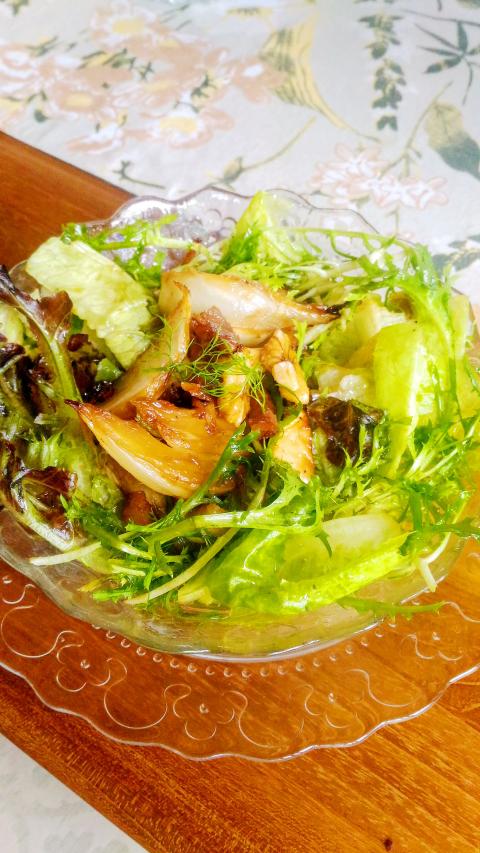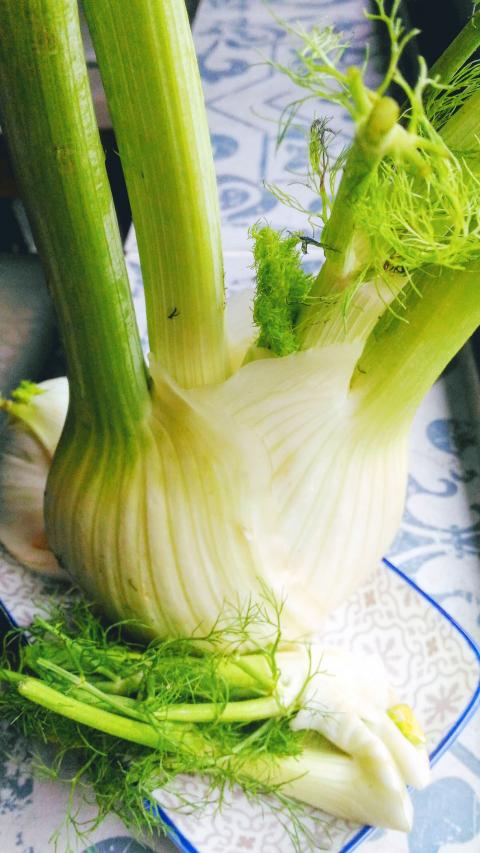When people talk about fennel in Taiwan, it is generally about leaf fennel, which is cultivated for the fronds and used more as a herb than as a vegetable. The familiar bulb fennel of Western cuisine, primarily Italian, has is own unique characteristics in the kitchen, and is quite a different beast to leaf fennel. The two are not interchangeable.
Bulb fennel is also called Florence fennel and while its fronds can be used, it is particularly cultivated for large bulb at its base. The fronds are an added extra, but are most often removed before sale as they wilt easily and spoil the appearance of the fennel bulb on the supermarket shelf and market stall.
As with zucchini (Taipei Times, July 22, 2017), another delicious vegetable little used in Taiwanese food, cultivation of fennel has become increasingly dependable in Taiwan to meet the needs of the growing number of Western restaurants around the country. While it remains expensive and often elusive, it availability is worth celebrating: in my case simply because it allows for the preparation of caramelized fennel and bacon salad (see accompanying recipe), one of my favorite salads — I suspect in large degree because eating it never feels like eating mere salad. That said, given Taiwan’s very warm climate, locally grown bulbs can be a little fibrous if allowed to bolt before harvest or to grow too large, so it is worth taking a bit of care with selection.

Photo: Ian Bartholomew
The notable characteristic of fennel is its taste and aroma of anise. This is not a flavor universally popular, but it should be noted that in fennel, this element is extremely muted and balanced with notes of grassy freshness. Bulb fennel is delicious eaten raw, and one of its most famous applications is the serving of paper thin slices of fennel lightly salted as a way of bringing a meal to an end, as its aromas sweeten the breath. Some Indian restaurants go so far as to offer fennel seeds (sometimes sugared) at the end of a meal for the same purpose, and also as a digestif to prevent indigestion after a heavy meal.
Thin slices of fennel can also be tossed into any kind of salad, pairing particularly well with celery. A mixture of fennel shavings with apple, frisee, romaine, oakleaf or other nice leaves, along with a scattering of walnuts, and pungent cheese like Roquefort and a quickly whisked up vinaigrette makes for a glorious light meal all on its own.
Raw bulb fennel, for all its many attractions, is no match for any preparation that sees the richly sweet flesh of the bulb come into close contact with heat, which draws out its sugars and creates luscious caramel flavors. As its alternative name of Florence fennel suggests, bulb fennel is closely associated with Italian cooking and is an integral part of the much vaunted Mediterranean diet. All sorts of studies have shown the presence of phytonutrients with impressive credentials as antioxidants and boosters of immune systems. It has loads of vitamin C, and its fiber, folate and potassium content are all good things in regard to cardiovascular health. High end supermarkets sometimes stock bulb fennel, as do some health food outlets that also have a fresh grocery section. Fennel is physically quite robust but its delicate flavor and aroma deteriorate quickly even with careful storage, so it is best to get it from a reputable source.

Photo: Ian Bartholomew
Warm salad with salt pork and
caramelized fennel
Recipe
(serves two)
Heat draws out the sugars in fennel and this makes it ideal for sautes and bakes that really jazz up its flavor profile. Subtle and mysterious when raw, put bulb fennel next to some heat and it really lets rip, releasing a rumbustious personality that gives even a salad a deeply satisfying body. This recipe calls for salt pork belly (see Taipei Times, Dec. 26, 2015 for the recipe), but that’s only because I make my own every month and it is always in my larder, but good bacon or pancetta are just fine.
Ingredients
For the fennel
2 slices of salted pork belly or pancetta, roughly chopped
1 medium sized fennel bulb
2 cloves of garlic, minced
2 tbsp brown sugar
olive oil
salt and pepper
For the dressing
2 tbsp olive oil
2 tbsp cider vinegar
salt and pepper
For the rest
mixed leaves
1 small green apple, thinly sliced
handful of walnuts, lightly toasted
Directions
1. Cut the fennel bulb into chunky wedges, removing any outer shoots that look too tough or fibrous, and place on a thick baking sheet, preferably non-stick.
2. Add the salt pork or pancetta and garlic. Sprinkle with sugar and season with salt and pepper.
3. Add a good glug of olive oil and mix with your hands, ensuring that the fennel and pork are well coated with the sugar and garlic.
4. Bake on an upper shelf in a preheated oven at 200c for about 15 to 20 minutes until the fennel has good golden color and the pork is crisp. Allow to cool for about 5 minutes.
5. Put the ingredients for the dressing in a jar and shake like you would a Bloody Mary. A whisk works as well, but I find the shaking method produces a glorious emulsion in seconds. This dressing is a little sharp, but will be balanced by the oil from the warm fennel and pork.
6. Drain off any excessive amounts of oil from the the fennel and bacon mixture and add to the salad leaves, tossing well. Add the dressing, walnuts and sliced apple. Adjust seasoning to taste.
7. Serve with thickly buttered toast or eat just as it comes.
Ian Bartholomew runs Ian’s Table, a small guesthouse in Hualien. He has lived in Taiwan for many years writing about the food scene and has decided that until you look at farming, you know nothing about the food you eat. He can be contacted at Hualien202@gmail.com.

Following the shock complete failure of all the recall votes against Chinese Nationalist Party (KMT) lawmakers on July 26, pan-blue supporters and the Chinese Communist Party (CCP) were giddy with victory. A notable exception was KMT Chairman Eric Chu (朱立倫), who knew better. At a press conference on July 29, he bowed deeply in gratitude to the voters and said the recalls were “not about which party won or lost, but were a great victory for the Taiwanese voters.” The entire recall process was a disaster for both the KMT and the Democratic Progressive Party (DPP). The only bright spot for

Water management is one of the most powerful forces shaping modern Taiwan’s landscapes and politics. Many of Taiwan’s township and county boundaries are defined by watersheds. The current course of the mighty Jhuoshuei River (濁水溪) was largely established by Japanese embankment building during the 1918-1923 period. Taoyuan is dotted with ponds constructed by settlers from China during the Qing period. Countless local civic actions have been driven by opposition to water projects. Last week something like 2,600mm of rain fell on southern Taiwan in seven days, peaking at over 2,800mm in Duona (多納) in Kaohsiung’s Maolin District (茂林), according to

Aug. 11 to Aug. 17 Those who never heard of architect Hsiu Tse-lan (修澤蘭) must have seen her work — on the reverse of the NT$100 bill is the Yangmingshan Zhongshan Hall (陽明山中山樓). Then-president Chiang Kai-shek (蔣介石) reportedly hand-picked her for the job and gave her just 13 months to complete it in time for the centennial of Republic of China founder Sun Yat-sen’s birth on Nov. 12, 1966. Another landmark project is Garden City (花園新城) in New Taipei City’s Sindian District (新店) — Taiwan’s first mountainside planned community, which Hsiu initiated in 1968. She was involved in every stage, from selecting

As last month dawned, the Democratic Progressive Party (DPP) was in a good position. The recall campaigns had strong momentum, polling showed many Chinese Nationalist Party (KMT) lawmakers at risk of recall and even the KMT was bracing for losing seats while facing a tsunami of voter fraud investigations. Polling pointed to some of the recalls being a lock for victory. Though in most districts the majority was against recalling their lawmaker, among voters “definitely” planning to vote, there were double-digit margins in favor of recall in at least five districts, with three districts near or above 20 percent in